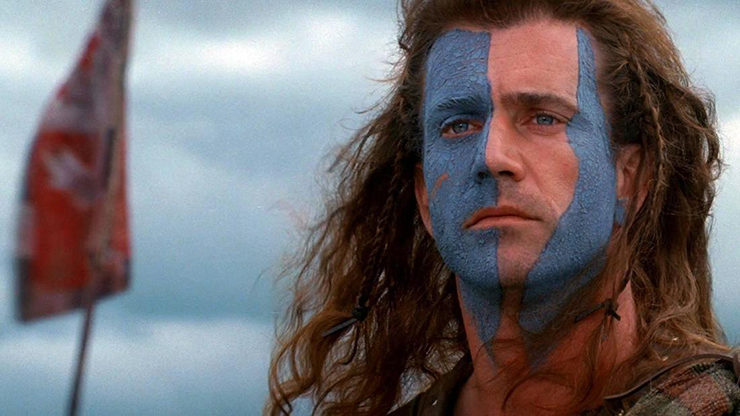This is your fault.
Yes, you.
You bugged me on Twitter, at cons, at every moment you could. “What about Braveheart?” you asked. “Braveheart is accurate, right?”
Well, in all honesty, I have some fond memories of the movie—that “insane Irishman” being one of them—but I also recall plenty that makes my historical heart cringe.
To be fair, though, it’s been many years since I watched Braveheart, Mel Gibson’s Oscar-winning 1995 film starring Mel Gibson as Scottish independence fighter William Wallace. Maybe it’s not as bad as I think it’ll be.
So let me fire up the DVD and see how this goes.
Hold on. Let me grab a Scotch.
Actually, the bottle.
Ok. Ready. Pressing ‘Play.’
So the film opens to scenic footage of Scotland, and even if my family didn’t have Scottish roots I’d be a big fan of such scenery. I love the beauty of stark landscapes, and Scotland has it in spades. On the historical side, though, it’s pretty strange that this opening scenery appears to all be from the West Highlands, which has little to do with Wallace’s life and career.
From what I recall, though, this is going to be the least of the historical sins in Braveheart.
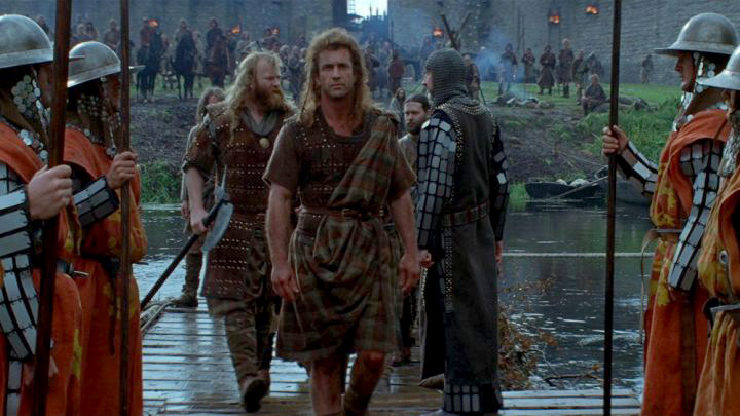
I do have to note, though, giving credit where it’s due, that this lovely footage is set to a marvelous first movement of what will prove to be one of the really great soundtracks. The late James Horner has a long list of terrific soundtracks to his name, and this is easily one of his finest. There’s a chapter of my second Shards novel, Gates of Hell, that was written to one of these tracks on repeat.
Alas, things take a turn for the worse the moment the narrator opens his mouth, after a title card tells us this is Scotland in 1280:
I shall tell you of William Wallace. Historians from England will say I am a liar, but history is written by those who have hanged heroes. The king of Scotland had died without a son, and the king of England, a cruel pagan known as Edward the Longshanks, claimed the throne of Scotland for himself.
Well, movie, I’m neither English nor a hangman, and you’re a bloody liar.
Braveheart is attempting a pre-emptive strike against people pointing out its gross inaccuracies by denigrating the very concept of historical accuracy. As you can imagine, this doesn’t sit well with me.
Look, it’s an old adage that history is written by the victors, and there’s certainly some general truth to the concept. The accounts of events tend to be those of the survivors, and the winners of events tend to be the ones who survive. But we have many accounts of the losers, too, including many from both Scots and English at this period in time. And not all winners’ accounts are false. In the end, historians like me simply have to assume that no single source is telling the unbiased and unvarnished truth. We must be sensitive to the biases of all our sources—losers and winners, hangmen and hanged—not just in how they tell what they tell, but also in how they choose what (and what not) to tell. Our recognition of possible inaccuracy, in other words, is a call for us to be even more vigilant in pursuing accuracy. It is not, dear Braveheart, permission to throw out the very concept.

So back to the movie and this scene set in 1280. Let’s take this line by line, shall we?
The king of Scotland had died without a son—
Pardon me, but no, he hadn’t. In 1280, Scotland’s King Alexander III was still alive, as were both of his sons, Alexander and David. Prince Alexander would die in 1284, David in 1281, and the king himself in 1286.
Jesus, Gibson—::rimshot::—you couldn’t look up like the most basic dates?
—and the king of England, a cruel pagan known as Edward the Longshanks—
Wait, what? A pagan?!?
The popular meaning of the word pagan is “non-Christian.” The earlier Classical Latin meaning was something akin to “peasant.” Neither descriptor in any way applies to King Edward I of England.
As for “Longshanks,” which the narrator says like it’s a condemnation, it meant that he had long legs. Edward was a tall man, it seems, which will not apply to Gibson’s casting of the otherwise awesome Patrick McGoohan in the role.
—claimed the throne of Scotland for himself.
In 1280? Nope. The king and both his sons were alive. And even after King Alexander III followed his sons to the grave in 1286 (he tumbled off his horse in the dark, poor fellow), he had an unborn child as heir. Then, when that child miscarried, there was still an heir: a granddaughter, Margaret of Norway.
But even after she died on her way to Scotland in 1290—the Middle Ages were rough, y’all—King Edward still didn’t claim the throne for himself. Various powerful families vied for control in Scotland, and Edward was brought in to arbitrate the claims. In 1292, through a decision that seems to be fair by the rules of the time, John Balliol was chosen to be king and matters were seemingly settled. Trouble was, Edward viewed the Scottish throne as less lofty to his own, and he wasn’t shy about saying so. Fed up, and pressured by internal forces, Balliol renounced any loyalty to Edward in March 1296. Edward, as was his custom, responded quickly. By July he had seized the important border town of Berwick-on-Tweed, forced Balliol to abdicate the crown, and effectively put Scotland under direct English rule … 16 years after Braveheart claims.
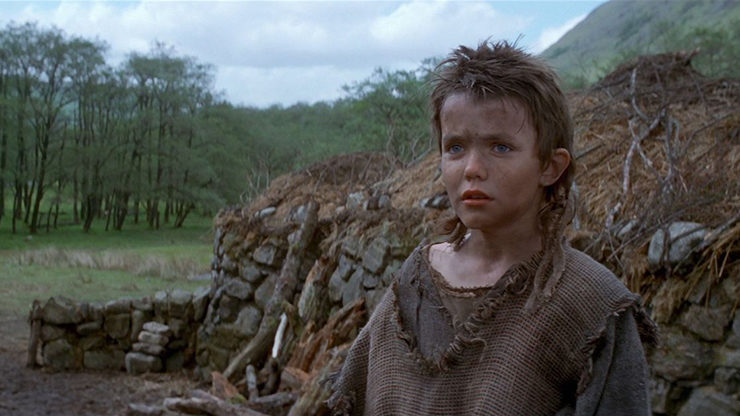
Oh don’t worry. It’s going to get worse. Our narrator continues:
Scotland’s nobles fought him and fought each other over the crown. So Longshanks invited them to talks of truce—no weapons, one page only.
This never happened.
We will subsequently see that all these nobles will be hanged by the “cruel” English. This, too, did not happen. As we’ve already noted, nothing like it even could have happened until 1296-1297, which happens to be when the real William Wallace appears in the real historical record.
When he does show up in our record at this time, Wallace is a grown man leading a local band of rebellious Scots during what historians now refer to as the First War of Scottish Independence. He is not a mullet-haired, dirt-covered kid in rags, who is introduced by our narrator thus:
Among the farmers of that shire was Malcolm Wallace, a commoner with his own lands. He had two sons—John and William.
So much ouch.
First, Medieval folks weren’t filthy. They bathed. They owned combs. They knew how to sew.
Second, we know that William Wallace had at least two brothers, Malcolm and John, that their father was named Alan, and that they were lesser nobility, not hovel-dwelling mud farmers.
The reason we get his pops called Malcolm here instead of Alan is because the movie is interested less in the real William Wallace (who named Alan his dad in a letter from 1297) than it is in a totally fabricated “William Wallace” who is the subject of The Wallace, a verse biography (ahem) written in the 1470s, roughly 170 years after its subject died, by a poet named Blind Harry.
Harry was writing in response to the massive popularity of a work called The Bruce, a verse biography of Robert the Bruce written in 1375 by John Barbour. Robert the Bruce was a real dude, a contemporary of Wallace, the guy whose nickname truly is “Braveheart,” and the one who actually managed to achieve Scottish independence and rule as King Robert I. He’s also the subject of a new Netflix movie, but that’s not what we’re here for today.
Turning back to Harry, you should know that his Wallace is heavily embellished. In fact, it’s mostly bullpucky. He straight-up steals stories from Barbour’s Bruce, changes the names, and gives them to his own hero. Harry wasn’t interested in creating objective history so much as he wanted to inspire his compatriots and create a new myth of Wallace that would push Bruce down a peg or two.
Which brings me to the fact that the narrator of Braveheart turns out to be Robert the Bruce (Angus Macfadyen).
Think about that.
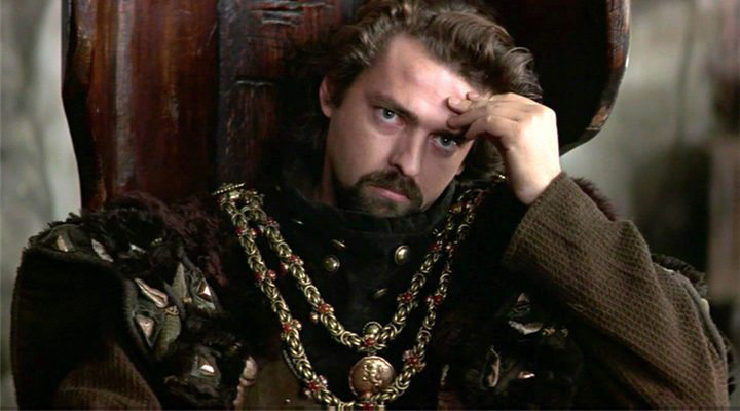
The Wallace steals from The Bruce to create a new, Wallace-centric myth of Scottish independence, and then Braveheart, to squeeze haggis in the wound, makes Robert the Bruce the friggin’ narrator of what is essentially The Wallace on Mad Max steroids stealing his bad-ass and well-earned nickname…and the first thing they have him do is attack history.
The flames. Flames on the sides of my face…
I already said that this early scene with all the Scottish nobles being hanged, for instance, couldn’t have happened in Wallace’s childhood. And that’s true. The story is ultimately based on a brief mention in The Bruce of two nobles being hanged in a barn in Ayr in 1306—a full year after Wallace was executed. Blind Harry took that reference, jacked it up to a whole bunch of Scottish nobles hanged in a barn, and then moved it back into the life of William Wallace, who after it happened locked the guilty English inside the same “Barns of Ayr,” as they came to be known, and burned the building down around them as they screamed. (Harry’s Wallace is a pretty nasty dude.) Braveheart then took Harry’s story and moved it back even further, into Wallace’s childhood and made him the wide-eyed witness to the tragedy.
Ugh.
Folks, I’m like three minutes into this thing, and I haven’t even bothered to talk about the totally nonsense 17th-century kilts that folks are wearing incorrectly.
But, hey, back to the plot and how William Wallace got his start.
The reality of how William Wallace came on the scene is that localized rebel groups popped up almost immediately after King Edward forced Balliol’s abdication, attacking English holdings and personnel. One of these groups conducted the so-called Action at Lanark: the May 1297 assassination of William Heselrig, the English sheriff there. As luck would have it, one of the Englishmen who almost died in the attack, a man named Thomas Grey, would go on to have a son, also named Thomas Grey, who wrote a very useful Anglo-Norman chronicle of the period called the Scalacronica.
We don’t really know why Wallace was in Heselrig’s court that day, but the Scalacronica tells us that a fight broke out. Wallace managed to escape, gathered some more men, then came back and killed the sheriff and a number of other English before setting fire to some buildings.
You’ll not be shocked when I note that this isn’t how Braveheart does it.
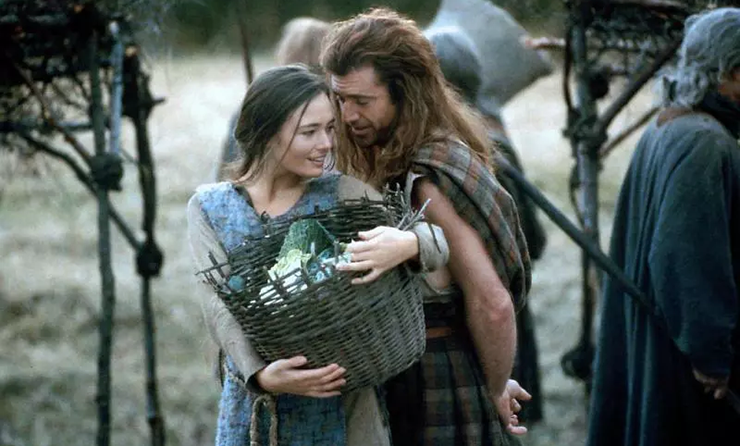
After all that opening bollocks, Braveheart’s Wallace starts his rebellion because the young hero (some years after the opening crap) falls in love with and secretly marries a lovely maiden named Murron (Catherine McCormack). Because their secret marriage has denied the sheriff his chance to have sex with her on their wedding night via the right of prima nocte (first night)—a right that Edward has gleefully declared while ickily eyeing Princess Isabella of France (Sophie Marceau)—the sheriff of Lanark gruesomely and publicly executes Murren, which brings mullet-haired Wallace and some of his buddies out to surprise attack the uniformed Englishmen. Wallace destroys the first guy with a ball-and-chain flail, then the rest of the Scots join in and the dastardly sheriff is dead and the rebellion well and truly begun.
My dear movie …
- jus prima nocte wasn’t a thing Edward tried to pull off.
- Princess Isabella was two years old when Wallace killed Heselrig (and nine years old and living in France when the movie later has Gibson having an affair with her).
- Wallace’s love was named Marion, not Murren.
- mullets belong in the 1980s, not the 1280s.
- common soldiers didn’t wear uniforms like this in the 13th century.
- ball-and-chain flail? Really? Are you trying to make me twitchy?
By the gods, the historical cock-ups become almost comical at some point.
Gibson has his Scots paint their faces with blue war-paint, for instance, making them look like World Cup fans.
The rationale, I imagine, is that the ancient people called the Picts are thought to have (maybe) done something like it and the Picts generally lived in what we now identify as “Scotland” and … well, that’s probably all the research that they managed. Problem is, the Scots in origin were invaders from Ireland who had literally driven out the Picts centuries earlier. It’s hard to imagine they would be dressing up like them.
The historical sins of this movie are just so many. I don’t have time to list them all.
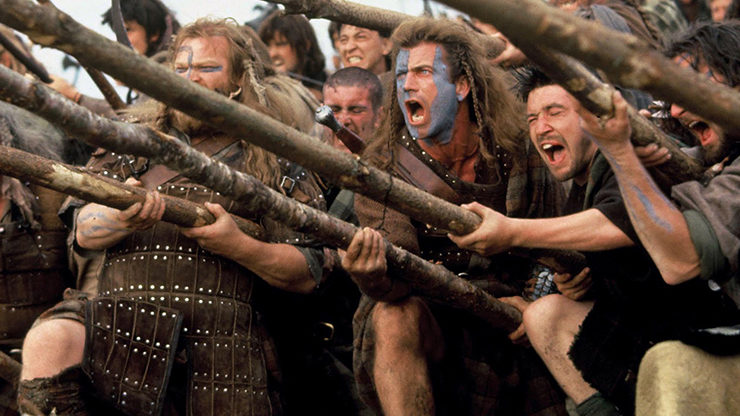
Yet I cannot move on without mentioning just one more.
One of the most important things we know Wallace did—by far the most famous thing he did—was to join forces with fellow rebel leader Andrew Moray to defeat an English army at the Battle of Stirling Bridge on 11 September 1297. This was the high point of Wallace’s career, since he would be defeated at the Battle of Falkirk on 22 July 1298 and spend the rest of his life in exile and on the run until the English captured him and executed him on 23 August 1305.
So, Stirling Bridge. An enormous moment for William Wallace and for Scottish history.
Wouldn’t it be nice if the movie depicted it with—I dunno, just spit-balling here—a bridge?
In short, if you want to know how accurate Braveheart is, here you go:
Wallace and company screaming for “freedom!” in their Pict-paint while dressed up in 17th-century kilts on a bridge-less meadow is the equivalent of me making a movie about the Battle of Bunker Hill in which I dress the American colonials in Star Trek uniforms, paint their faces with made-up “Native American” designs … and then shot the film in a Florida parking lot.
Mike’s Medieval Ratings
Authenticity: 1 of 10 plaid kilts
Just Plain Fun: 7 of 10 insane Irishmen
 Michael Livingston is a Professor of Medieval Culture at The Citadel who has written extensively both on medieval history and on modern medievalism. His historical fantasy trilogy set in Ancient Rome, The Shards of Heaven, The Gates of Hell, and The Realms of God, is available from Tor Books.
Michael Livingston is a Professor of Medieval Culture at The Citadel who has written extensively both on medieval history and on modern medievalism. His historical fantasy trilogy set in Ancient Rome, The Shards of Heaven, The Gates of Hell, and The Realms of God, is available from Tor Books.










